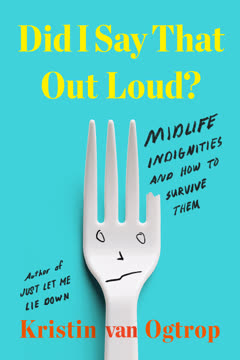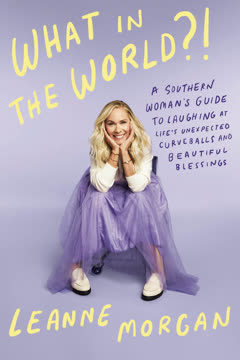Key Takeaways
1. Embrace Midlife Chaos and Perspective
Being a person with thoughts isn’t all bad.
Accepting the shift. Midlife brings a profound shift from linear "thinking" to a chaotic "circus train" of "thoughts," a realization that can be both disorienting and liberating. Instead of fighting this mental scatter, the author suggests embracing it, finding entertainment in the mind's colorful disarray, and recognizing that this new mental landscape is a natural part of aging. This acceptance allows for a kinder, more forgiving approach to oneself and the world.
Valuing feelings over thoughts. As one ages, the reliability of thoughts diminishes, making feelings the enduring core of existence. The author learns that while thoughts are unpredictable and often unproductive, feelings linger, providing a deeper sense of meaning and connection. This perspective helps reframe midlife indignities—like sleepless nights, aging parents, or a house full of clutter—as minor frustrations when compared to the profound sadness and grief that accumulate over a lifetime.
Gaining perspective. The accumulation of life experiences, particularly witnessing terrible things happen to loved ones, fosters a profound sense of perspective. This leads to a realization that one is not special, but rather "pretty much like everyone else," which in turn cultivates greater understanding and forgiveness. Insignificant worries, such as college admissions or physical imperfections, fade into the rearview mirror, replaced by a self-actualized indifference to external validation.
2. The Body's Betrayals and Mortality
This big, new scar, though, sends a different message: Guess what, girl—you are mortal!
Sudden confrontation with mortality. A seemingly minor back pain escalates into emergency surgery to remove a plastic fork tine that perforated the author's stomach, serving as a stark, unexpected reminder of mortality. This "Fork Lady" experience, marked by a "giant purple scar," transforms a sense of idiocy from past clumsy mishaps into a profound feeling of luck and awareness. The body, once a reliable vessel, becomes a source of unpredictable betrayals, from toenails breaking to mysterious abdominal pains.
The body's decline. Midlife brings a cascade of physical indignities and the constant need for "deferred maintenance," from basal cell skin cancer and fractured teeth to receding gums and a "disappearing top lip." This relentless physical decay, coupled with the financial burden of repairs, creates a sense of being overwhelmed. The author humorously laments the time spent on maintenance, contrasting it with the carefree vitality of youth, and questions how anyone over sixty-five manages to do anything else.
Acceptance and humor. Despite the frustrations, there's an underlying current of acceptance and dark humor. The author finds herself contemplating the "surprise fart" and the indignity of a colonoscopy, yet ultimately acknowledges the power of denial (Advil) as a coping mechanism. The physical changes, while irritating, are framed as minor in the grand scheme, fostering a sense of gratitude for simply being alive and healthy enough to experience them.
3. Navigating the Digital Age and Its Demands
No, Drybar (and Uber and Everlane and Paperless Post), I do not want to be in a committed, dynamic relationship with you.
The "rate everything" culture. Modern life is plagued by a pervasive "rate-everything" culture, driven by platforms like Yelp, which transforms simple transactions into multi-step processes involving photos, social media posts, and mandatory reviews. This constant demand for feedback is seen as a "time-suck factor" and an unwelcome intrusion, eroding the mystery of life and forcing unwanted "committed, dynamic relationships" with businesses.
Generational tech gap. The author struggles to keep pace with her children's rapidly evolving social media landscape, feeling like "Alice in Wonderland down the rabbit hole" with each new platform. From Facebook to Twitter, Instagram, and the ultimate "Snapchat? I Give Up," each new app is less intuitive than the last, creating a chasm of understanding between parent and child. This digital divide highlights the author's "clueless older person" status, leading to both frustration and a touch of self-embarrassment.
Loss of privacy and control. The author's "contract" with her children—paying for their phones in exchange for social media access—is a constant negotiation of boundaries and privacy. The ephemeral nature of Snapchat, designed to prevent parental embarrassment, symbolizes the children's desire for a digital space free from adult oversight. This struggle underscores the broader theme of parents losing control over their children's lives, both online and off, as they navigate an increasingly complex technological world.
4. The Evolving Landscape of Parenting
Miracles like this do not disappoint—at least, not at first.
The narcissistic ideal. Parenting begins as an "exercise in narcissism," where children are seen as perfect extensions of oneself, destined for greatness. This "Mobius strip of parent-child wonder and perfection" lasts until around age nine, fueled by the belief in "unlimited human potential" and the joy of every small milestone. This initial phase is characterized by intense involvement, from signing up for countless activities to meticulously pruning their development, driven by the conviction that parents know what's best.
Disappointment and self-doubt. As children grow, the "disappointment creeps in" when they fail to meet idealized expectations, becoming "more and more, well, average." This leads to self-doubt, as parents question their methods and compare their children to others. The author humorously recounts her "punishing self-examination" over her son's lack of linguistic genius, attributing it to "too much screen time" or "parental indifference," a "lazy exhaustion" that sets in with each additional child.
Acceptance and bittersweet sadness. The third phase of parenting brings acceptance, as children become "well-adjusted young adults" responsible for their own "flaw maintenance." The focus shifts from changing them to understanding them as "fellow travelers." This acceptance, however, is tinged with a "sadness"—a "disappointment all its own"—as the intense, hands-on period of childhood ends, leaving parents with an "empty box" feeling and a wistful longing for the days when they were constantly needed.
5. Career Reinvention and the Search for Meaning
There is this little thing called meaning, and suddenly you want your days to be filled with it.
The end of a long career. After decades in a "perfect" magazine career, the author finds herself unemployed, facing the "long goodbye" of a dying industry. The initial "Stockholm syndrome" of corporate life gives way to disillusionment, as the job becomes about "firing people" due to "bullshit 'efficiency'" rather than creative enterprise. This period is marked by a "bubbling, subcutaneous anger" and a profound sense of being a "fraud," leading to the realization that the job no longer provides meaning.
The quest for meaning. Post-unemployment, the author embarks on a "quest to find my One True Thing," seeking a job that will fill her days with meaning and purpose. This journey involves looking back at her past self, trying new hobbies like pottery (with disastrous results), and volunteering. The experience of helping a Syrian refugee family, for instance, provides a stark "perspective" on her own search for meaning, highlighting the privilege of her "first-world problems."
Humility and unexpected lessons. Leaving a long career forces a confrontation with humility and failure, squelching the belief that success in one area guarantees it in another. The author learns that her "skill set so narrow" might only excel at one thing, leading her to poll friends for their "non-professional" skills. Ultimately, the search for meaning is less about finding a perfect job and more about embracing the present, finding purpose in small domestic tasks, and recognizing that "enough" is not always the same as "important."
6. The Enduring Value of Friendship
You are my Yes; I agree with you; I understand. You are my 100 percent.
Friendship's evolution. Friendship transforms from the "intoxicating, nearly all-consuming" love of childhood to a more complex, noisy chorus in adulthood, where new friends must join an already crowded life. The author reflects on losing touch with early, intense friendships, likening them to "big pieces of costume jewelry" that are "too meaningful to throw out, too outdated to wear." As backstories lengthen, it becomes harder for new friends to "fully know you," yet the need for connection remains.
The "friendship toolbox." Despite the challenges, adult friendships are "tools of tremendous utility, variety, and importance," providing stability and guidance. The author's book group, meeting for twenty years, exemplifies this, serving as a "buffer against the modern world" and a vital source of laughter, support, and shared history through life's "tragicomedy." These women, who have "weathered together: divorce, illness, death," represent the enduring power of collective friendship.
Beyond intense ties. The author acknowledges the value of "weak ties"—casual interactions with pharmacists, dry cleaners, or mail carriers—which sociologists believe are crucial for mental and psychological health. While these low-stakes acquaintances offer pleasant interactions, they don't replace the deep connection of true friends. Ultimately, the author realizes that her book group, with its "enthusiasm and tenderness" and "full body hug," embodies the "100 percent" understanding and agreement she seeks, a testament to the irreplaceable role of chosen family.
7. Love in Long-Term Marriage
Trust and romance exist symbiotically, rising and falling and completely dependent on each other like kids on a playground seesaw.
Beyond romantic ideals. The author challenges idealized notions of love, like the 1970s De Beers ad suggesting "talking for hours and never saying a word." After twenty-nine years of marriage, she finds that silent hours often mean anger or listening to podcasts at 1.5x speed. True, deep, lasting love is not telepathic but built on "quotidian details," shared inside jokes, and the mundane "push-and-pull of shared tasks and responsibilities."
The puzzle of a spouse. Her husband, the "Howard to my Judy," remains a "puzzle that I’m still trying to solve," preferring to remain unknown even to her. This quiet, methodical nature contrasts with her own impatience and boorishness, yet it is precisely this difference that makes him the person she wants to experience life with. This dynamic, along with three decades of "inside jokes," forms the "too much of an investment to abandon" that keeps their marriage strong.
Protecting the partnership. Marriage, like a body, requires protection and "deferred maintenance." The author learns that choosing not to fight over "stupid shit" is crucial, as arguments, once "two sharp rocks in a rock tumbler," eventually smooth out the edges. Divorce, while always "waving at you from the back of the room," is not a desirable alternative. Ultimately, love in a long marriage is a daily choice to fight for the marriage, built on unwavering trust and the shared journey through life's ordinary, wonderful, and difficult moments.
8. Confronting Loss and Unexpected Kindness
In every tragedy, large or small, there are moments of remarkable grace.
The suddenness of loss. The disappearance and eventual drowning of Rebel, the family's "dim-witted black pup," in a frozen lake serves as a "small tragedy" that profoundly impacts the author and her family. This unexpected loss, occurring after a period of career disillusionment and national political turmoil, becomes a "clarifying" event, stripping away quotidian worries and forcing a confrontation with real grief. The author grapples with "a long list of if-onlys" and the "jagged pain of not knowing."
Community and kindness. The search for Rebel mobilizes an outpouring of "overwhelming" kindness from strangers and neighbors, who offer stories, help with flyers, and emotional support. From the Price Chopper employee to the dog warden and the pet tracker, Jamie Genereux, these individuals demonstrate that "good goes around and around and around," providing comfort and a sense of belonging in a time of profound vulnerability. This collective effort highlights the unexpected grace found in shared human compassion.
The clarifying nature of real worry. The experience of losing Rebel, coupled with other family traumas like car accidents and a friend's premature death, shifts the author's perspective on worry. The "stupid things" she used to worry about are replaced by "real worry," which, while horrible, is also "clarifying." This period of grief and the kindness received ultimately broaden her worldview, making her realize that even in tragedy, there are moments that connect her more deeply to humanity and her community.
9. Aging Parents and the Inevitable Goodbye
You are powerless against the forward momentum.
The enduring tether. The author describes herself as "tethered to my parents as if we were climbing a mountain together," a profound connection that persists even as they enter their eighties. Despite her mother's "get-on-with-it-ness" and readiness for her children to leave, the author, at fifty-six, is "still not ready for her to leave." This relationship is a source of immense gratitude, providing a "ballast in the hull" that keeps her on course through life's storms.
The long goodbye. The process of aging, both for parents and oneself, is framed as a "very, very long goodbye." This includes the subtle signs of cognitive decline, like her father's accidental breakfast in a stranger's condo, and the physical indignities that accumulate. The author contemplates the "unbelievable" reality that her parents will one day die, leaving a gap that memories may not fully fill, and wonders who will provide comfort and guidance when they are no longer there.
Preparing for the inevitable. Parents, through their actions and unspoken lessons, teach their children how to navigate life, from practical skills to emotional resilience. The author's mother, a "house with lighted windows," remains a source of wisdom and unwavering belief in her daughters' capabilities. While the "urgent" demands of daily life often override the "important" task of cherishing these moments, the author acknowledges that this prioritization is a form of "self-protection" against the "powerlessness" of the inevitable loss.
10. Finding Peace Amidst Domestic Demands
I’m just waiting for “wife and mother” to appear on that McKinsey list, because I’ve got a bag packed and am ready to hop in my driverless car and hit the road.
Embracing automation. Faced with the relentless demands of domestic life, the author finds unexpected solace and even "love" in automation, particularly her Roomba. This "cute little round guy" symbolizes the desire to offload tedious tasks, anticipating a future where robots might even take over the role of "wife and mother." This embrace of technology is a humorous coping mechanism for the overwhelming nature of household responsibilities and the author's increasing laziness.
The "Mom's Little Panic Room." The concept of a "she shed" is re-imagined as "Mom's Little Panic Room™"—a Kevlar-reinforced bunker designed for "impenetrable escape" from the "terrifying demands" of disorganized children and husbands. This fantasy highlights the profound need for personal space and quiet amidst the chaos of a "testosterone-filled household," where the author is constantly needed to locate missing items and manage endless domestic duties.
The "fratermily" during a pandemic. The coronavirus pandemic transforms the author's home into a "fratermily," where middle-aged parents and three adult sons are "crammed together under one roof." This forced cohabitation exacerbates domestic chaos, with "meal plans in shambles" and "cleaning schedules flown out the window." The author humorously contrasts her "quietness, order, evenly distributed domestic duties" with her sons' "sleeping till noon, arguing about whose turn it is to take out the recycling," ultimately finding fleeting moments of "friendship" amidst the "plague of locusts."
Last updated:
Review Summary
Did I Say That Out Loud? is a humorous and relatable collection of essays about midlife experiences. Reviews praise van Ogtrop's wit, honesty, and self-deprecating humor in tackling topics like parenting, aging, and career changes. Many readers found the book entertaining and poignant, appreciating the author's candid reflections on life's challenges. Some criticized it as privileged or unrelatable, but most enjoyed the humorous anecdotes and insights. The book resonated particularly well with middle-aged women, who found comfort in van Ogtrop's shared experiences and observations.
Similar Books
Download PDF
Download EPUB
.epub digital book format is ideal for reading ebooks on phones, tablets, and e-readers.







